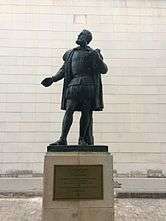Luís de Camões
Luís Vaz de Camões (Portuguese pronunciation: [luˈiʒ ˈvaʒ dɨ kaˈmõjʃ]; sometimes rendered in English as Camoens or Camoëns, e.g. by Byron in English Bards and Scotch Reviewers, /ˈkæm oʊˌənz/; c. 1524 or 1525 – 20 June [O.S. 10 June] 1580) is considered Portugal's and the Portuguese language's greatest poet. His mastery of verse has been compared to that of Shakespeare, Vondel, Homer, Virgil and Dante. He wrote a considerable amount of lyrical poetry and drama but is best remembered for his epic work Os Lusíadas (The Lusiads). His collection of poetry The Parnasum of Luís de Camões was lost in his lifetime. The influence of his masterpiece Os Lusíadas is so profound that Portuguese is sometimes called the "language of Camões".
Luís de Camões | |
|---|---|
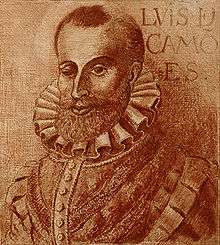 Portrait c. 1577 | |
| Born | Luís Vaz de Camões c. 1524-1525 Lisbon(?), Coimbra(?), Constância(?) or Alenquer(?), Kingdom of Portugal |
| Died | 20 June [O.S. 10 June] 1580 (aged 55-56) Lisbon, Kingdom of Portugal |
| Occupation | Poet |
| Alma mater | University of Coimbra |
| Period | Portuguese Renaissance |
| Genre | Epic poetry |
| Literary movement | Classicism |
| Notable works | The Lusiads |
| Relatives | Camões Family |
Background
Many details concerning the life of Camões remain unknown, but he is thought to have been born around 1524. Luís Vaz de Camões was the only child of Simão Vaz de Camões and wife Ana de Sá de Macedo.[1] His birthplace is disputed. Lisbon the capital where he died, Coimbra where he studied or Alenquer that is frequently presented as his birthplace, based on interpretation of Lusiadas, that mentioned Alenquer several times, and the biographical poem (157) below.
“No mundo poucos anos, e cansados, vivi, cheios de vil miséria dura; foi-me tão cedo a luz do dia escura, que não vi cinco lustros acabados. Corri terras e mares apartados buscando à vida algum remédio ou cura; mas aquilo que, enfim, não quer ventura, não o alcançam trabalhos arriscados. Criou-me Portugal na verde e cara pátria minha Alenquer; mas ar corruto que neste meu terreno vaso tinha, me fez manjar de peixes em ti, bruto mar, que bates na Abássia fera e avara, tão longe da ditosa pátria minha!”,
the translation says
“In this world only some few years I lived, and tired, full of vile and hash misery; a dark Light came to me (soul) so early when I didn't even had yet 25 years old. I ran apart lands and seas seeking some medicine or cure for this in life; but what, finally, didn’t got any luck, And risky jobs did not help reach any luck.
Portugal created me in the green and dear homeland of my Alenquer; but the corruption, air that I had in this vase land, it made me now eat fish in you, rough sea, which strikes wild and mean on the Abassia, so far from my blessed homeland!“
Even with this biographic poem stating that is homeland is Alenquer, there ate still interests disputing is birth place. His mother Ana de Sá was also from Alenquer and also related do the famous humanist Damião de Gois, also from Alenquer.
Constância has a museum about him where he was a period in jail, due to that they buit statue of him can be found in the town, but it’s not said in the Constância that it was his homeland.
The Camões family was originally Galician, that passed to the northern Portuguese region of Chaves near Galicia. At an early age, his father Simão Vaz left his family to pursue personal riches in India, only to die in Goa in the following years. His mother was later remarried. His mother was from Alenquer, daughter of Jorge de Macedo, and sister in law of Rui Dias de Gois from Alenquer.
Camões lived a semi-privileged life and was educated by Dominicans and Jesuits. For a period, due to his familial relations he attended the University of Coimbra, although records do not show him registered (he participated in courses in the Humanities). His uncle, Bento de Camões, is credited with this education, owing to his position as Prior at the Monastery of Santa Cruz and Chancellor at the University of Coimbra.
He frequently had access to exclusive literature, including classical Greek, Roman and Latin works; he read Latin and Italian, and wrote poetry in Spanish.[2]
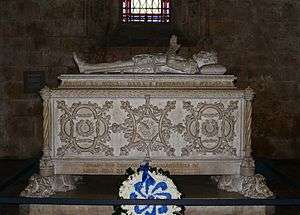
Camões, as his love of poetry can attest, was a romantic and idealist. It was rumored that he fell in love with Catherine of Ataíde, lady-in-waiting to the Queen, and also Princess Maria, sister of John III of Portugal. It is also likely that an indiscreet allusion to the king in his play El-Rei Seleuco, as well as these other incidents, may have played a part in his exile from Lisbon in 1548. He traveled to the Ribatejo where he stayed in the company of friends who sheltered and fed him. He stayed in the province for about six months.[2]
He enlisted in the overseas militia, and traveled to Ceuta in the fall of 1549. During a battle with the Moors, he lost the sight in his right eye. He returned to Lisbon in 1551, a changed man, living a bohemian lifestyle. In 1552, during the religious festival of Corpus Christi, in the Largo do Rossio, he injured Gonçalo Borges, a member of the Royal Stables. Camões was imprisoned. His mother pleaded for his release, visiting royal ministers and the Borges family for a pardon. Released, Camões was ordered to pay 4,000 réis and serve three years in the militia in the Orient.
He departed in 1553 for Goa on board the São Bento, commanded by Fernão Alves Cabral. The ship arrived six months later. In Goa, Camões was imprisoned for debt. He found Goa "a stepmother to all honest men", and he studied local customs and mastered the local geography and history. On his first expedition, he joined a battle along the Malabar Coast. The battle was followed by skirmishes along the trading routes between Egypt and India. The fleet eventually returned to Goa by November 1554. During his time ashore, he continued his writing publicly, as well as writing correspondence for the uneducated men of the fleet.
At the end of his obligatory service, he was given the position of chief warrant officer in Macau. He was charged with managing the properties of missing and deceased soldiers in the Orient. During this time he worked on his epic poem Os Lusíadas ("The Lusiads") in a grotto. He was later accused of misappropriations and traveled to Goa to respond to the accusations of the tribunal. During his return journey, near the Mekong River along the Cambodian coast, he was shipwrecked, saving his manuscript but losing his Chinese lover, Dinamene. His shipwreck survival in the Mekong Delta was enhanced by the legendary detail that he succeeded in swimming ashore while holding aloft the manuscript of his still-unfinished epic.[2]
In 1570 Camões finally made it back to Lisbon, where two years later he published Os Lusíadas, for which he was considered one of the most prominent Iberian poets at the time.[3] In recompense for this poem or perhaps for services in the Far East, he was granted a small royal pension (15000 réis) by the young and ill-fated King Sebastian (ruled 1557–1578).
In 1578 he heard of the appalling defeat of the Battle of Alcácer Quibir, where King Sebastian was killed and the Portuguese army destroyed. The Castilian troops were approaching Lisbon when Camões wrote to the Captain General of Lamego: "All will see that so dear to me was my country that I was content to die not only in it but with it". Camões died in Lisbon in 1580, at the age of 56. The day of his death, 10 June OS, is Portugal's national day. He is entombed in the Santa Maria church, part of the Jerónimos Monastery complex, near Vasco da Gama, in the parish of Belém in Lisbon.
Bibliography
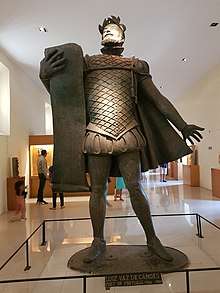
- The Lusiads
- The Parnasum of Luís Vaz (lost)
- Lyric Poems
- Auto dos Anfitriões
- Auto El-rei Seleuco
- Disparates da Índia
- Auto do Filodemo
- Letters
- English translations
- Os Lusíadas, Manuel Nunes Godinho, 19th century[4]
- The Lusiadas of Luiz de Camões. Leonard Bacon. 1966.
- Luis de Camões: Epic and Lyric. Keith Bosley. Carcanet, 1990.
- The Lusiads. Trans. Landeg White. Oxford: Oxford UP, 2002. ISBN 0-19-280151-1.
- Luis de Camões, Selected Sonnets: A Bilingual Edition. Ed. and trans. William Baer. Chicago: U of Chicago P, 2005. ISBN 978-0-226-09266-9. (Paperback publ. 2008, ISBN 978-0-226-09286-7)
- The Collected Lyric Poems of Luís de Camões Trans. Landeg White. Princeton: Princeton UP, 2008. ISBN [5]
- Biography and textual study in English
- Life of Camões. John Adamson. Longman, 1820.
|
In culture
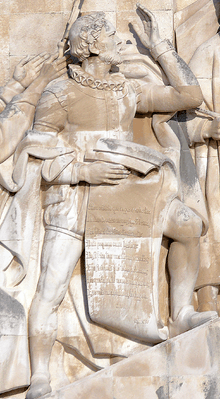
- Camões is the subject of the first romantic painting from a Portuguese painter, A Morte de Camões (1825), by Domingos Sequeira, now lost.
- He is one of the characters in Gaetano Donizetti's grand opera Dom Sébastien, Roi de Portugal.
- Camões figures prominently in the book Het verboden rijk (The Forbidden Empire) by the Dutch writer J. Slauerhoff, who himself made several voyages to the Far East as a ship's doctor.
- A museum dedicated to Camões can be found in Macau, the Museu Luís de Camões.
- In Goa (India) the Archeological Museum at Old Goa (which used to be a Franciscan monastery) houses a 3 meters high bronze statue of Luís de Camões. The statue was originally installed in the garden in year 1960 but was moved into the museum due to public protest after Goa's annexation to India. Another Camões monument in Goa, India – "Jardim de Garcia da Orta Garden" (popularly known as Panaji Municipal Garden) has a 12 meter high pillar in the center.
- A seamount in the Indian Ocean is named after him.[8][9]
- Institute Menezes Braganza in Panaji, Goa has grand Azulejos adorning its walls. These ceramics depict scenes from Os Lusíadas.
See also
Notes
- "Luís Vaz de Camões". GeneAll.net. Retrieved 2013-10-21.
- Chisholm 1911.
- Aguiar e Silva (2011, "Cânone literário português e Camões (O)"). Historian Pero de Magalhães Gândavo wrote in 1574 that "time will never triumph over Camões's fame" (idem, ibidem)
- "The Lusiads". World Digital Library. 1800–1882. Retrieved 2013-08-31.
- "The Laureate of Hard Luck: 'The Collected Lyric Poems of Luís de Camões' - The New York Sun". Nysun.com. Retrieved 2013-10-21.
- "Camoens: His Life and His Lusiads. A Commentary by Richard Francis Burton". Burtoniana.org. Retrieved 2013-10-21.
- "The place of Camoens in literature : Nabuco, Joaquim, 1849-1910 : Free Download & Streaming : Internet Archive". Archive.org. Retrieved 2013-10-21.
- "Camões Seamount" Marine Gazetteer
- "Camões Seamount: Undersea Features" Geographic.org
References
- Chisholm, Hugh, ed. (1911). . Encyclopædia Britannica. 5 (11th ed.). Cambridge University Press.
- Saraiva, José Hermano (1978). A Vida Ignorada de Camões (2ª ed). Mem Martins: Europa-América.
- Aguiar e Silva, Vítor (2011). Dicionário de Luís de Camões. Alfragide: Editorial Caminho. ISBN 9789722125154.
Further reading
- Hart, Henry Hersch. Luis de Camoëns and the Epic of the Lusiads, University of Oklahoma Press, 1962.
- Willis, Clive. "Camões, Prince of Poets". HiPLAM, University of Bristol, 2010. ISBN 0-9552406-6-2, ISBN 978-0-9552406-6-9
External links
| Wikiquote has quotations related to: Luís de Camões |
| Wikisource has original works written by or about: Luís de Camões |
| Wikimedia Commons has media related to Luís de Camões. |
- Works by Luís de Camões at Project Gutenberg
- Works by or about Luís de Camões at Internet Archive
- Works by Luís de Camões at LibriVox (public domain audiobooks)

- Luis Vaz de Camões – Catholic Encyclopedia article
- Rimas by Luís de Camões. Editor: Álvaro Júlio da Costa Pimpão. Coimbra: Acta Universitatis Conimbrigensis, 1953, 460 p.
- The Presence of Camoes: Influences on the Literature of England, America, and Southern Africa by George Monteiro. Lexington: University Press of Kentucky, 1996, 189+10 pp.
